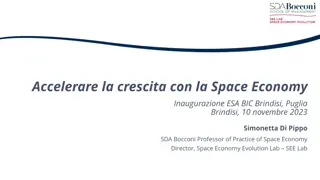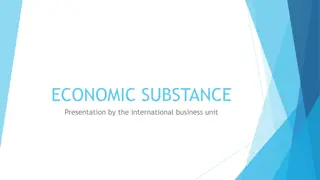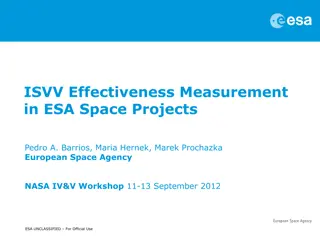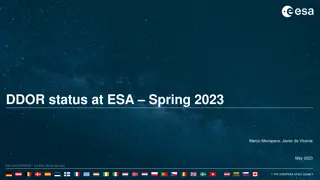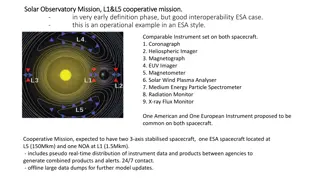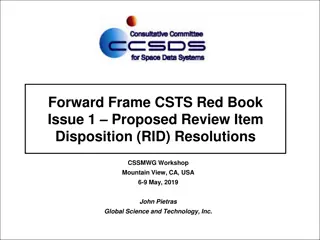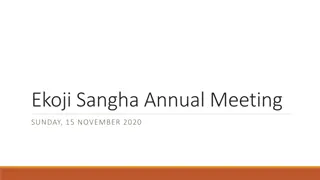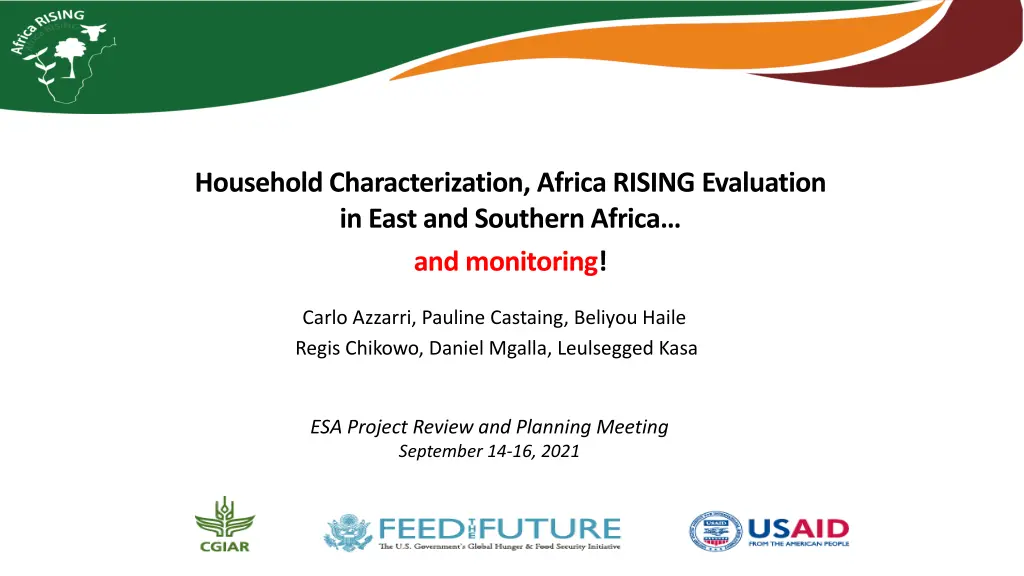
Household Characterization and Livelihoods Assessment in Africa RISING Evaluation
Explore the household characterization and livelihoods assessment conducted in the Africa RISING Evaluation in East and Southern Africa. The evaluation focuses on market integration, poverty, impact assessment, and monitoring. Gain insights into the stepwise patterns from low yield to high yield, market integration, food security, and income. Understand the linkages between market integration, agronomic practices, and economic outcomes. Analyze economic indicators based on input market integration levels.
Download Presentation

Please find below an Image/Link to download the presentation.
The content on the website is provided AS IS for your information and personal use only. It may not be sold, licensed, or shared on other websites without obtaining consent from the author. If you encounter any issues during the download, it is possible that the publisher has removed the file from their server.
You are allowed to download the files provided on this website for personal or commercial use, subject to the condition that they are used lawfully. All files are the property of their respective owners.
The content on the website is provided AS IS for your information and personal use only. It may not be sold, licensed, or shared on other websites without obtaining consent from the author.
E N D
Presentation Transcript
Household Characterization, Africa RISING Evaluation in East and Southern Africa and monitoring! Carlo Azzarri, Pauline Castaing, Beliyou Haile Regis Chikowo, Daniel Mgalla, Leulsegged Kasa ESA Project Review and Planning Meeting September 14-16, 2021
Outline 1. Characterization (livelihoods, market integration, poverty, ) 2. Difference-in-differences (DiD) and impact of AR 3. Monitoring continued from yesterday 4. Conclusions 5. Next steps
3 1. Characterization Stepwise pattern from low yield and market integration to high yield, market integration, food security, and income Poor Non poor (>$1.90/day) Livestock as business opportunity Increased options and assets Build household assets Increase market orientation Linkage crop- livestock Livestock sold for cash Intensification of labor & on-farm resources Crop diversification Basic agronomic practices Increased demand on labor, capital, land, markets, institutions
1. Characterization /contd Livelihoods based on the contribution of different activities to total household income o Diversifiers; agr. specializers; specializers in wage employment; specializers in self-employment Extent of integration into agricultural input and output markets for diversifiers and agr. specializers. o Tercile of index for input market integration (low, medium, high) o Tercile of agr. production that was sold (low, medium, high) Linkages between market integration and various agronomic and economic outcomes Typology based on food security and poverty o Successful : food secure andnon-poor (>=$1.9) o Struggling : food insecure and/or poor (<$1.9) MARFES (2019) and TARBES (2014) data
1. Livelihoods, poverty, and food security Cross-country difference in the incidence of food security and likelihood of being non-poor by livelihoods Agr. specialization the most common in both countries (as expected) Highest share of food secure (FS) and non-poor (NP) among agr. specializers and self-employed in MWI Highest FS and NP among self-employed and wage employment specializers in TZA
1. Economic indicators by INPUT market integration Farms with highest input market integration (green) -> more productive, highest net on-farm income, most diversified production, most diversified diet, more likely to be food secure (both self-reported and based on caloric requirements), more likely to be non-poor
1. Economic indicators by OUTPUT market integration Better agr. outcomes (productivity, diversity, income) among those with higher output market integration Higher output market integration associated with enhanced food security, income, and dietary diversity
2. Difference-in-differences (DiD) and impact of AR Malawi o MARBES (2013) and MARFES (2019) o Discrepancy in program participation status between baseline and follow-up based on data from different sources (self-reported participation status during follow-up, participation data compiled by M&E officer) o Current results based on self-reported participation data, with AR treatment defined as participation for at least three years (including 2019). Evaluation results sensitive to definition of AR treatment (e.g., last year, at least three years but not necessarily in 2019) Tanzania o Tanzania follow-up (TARFES) could not be implemented due to IRB s concern about lack of COVID-19 data in Tanzania o Similar analysis as for Malawi to be conducted after follow-up survey Zambia o Ex-ante evaluation conducted with Zambia colleagues; no info at baseline for DiD
2. Difference-in-differences (DiD) and impact of AR Difference-in-Differences (DiD) impact estimate Note: Y1B = outcome of treated at baseline Y1E = outcome of treated at endline Y0B = outcome of control at baseline Y0E = outcome of control at endline
2. DiD results for Malawi household level indicators AR treated- t1 c1 Inorganic fertilizer used (kg/ha) 135.97 Agricultural labor (person-days/ha) 145.38 Cereal-legume intercropping 0.86 Received extension services 0.99 Yield of maize (ton/ha) 1.37 Yield of groundnut (ton/ha) 1.80 Yield of bean (ton/ha) 0.59 Yield of soybean (ton/ha) 0.87 Tropical livestock units 0.46 Total value of animals owned ('000 MWK) 76.99 Durable agricultural assets (index) 0.17 Durable non-agricultural household assets (index) -0.01 Grows cereals 1.00 Grows starchy roots and tubers 0.08 Grows vegetables 0.05 Grows fruits 0.05 Grows legumes and nuts 0.98 Grows cash crops 0.10 On-farm production diversity 3.82 Number of (12) food groups consumed 9.18 Food secure (caloric consumption > MDER) 0.47 Per capita Expenditure per day in 2013 and 2019 PPP 2.26 Non poor (>$1.9 PPP) 0.36 Value of all crops harvested(MWK) ('000) 232.92 note: .01 - ***; .05 - **; .1 - *; AR treated- t0 c2 94.03 297.44 0.82 0.82 2.33 1.26 0.55 1.69 0.34 48.73 -0.01 -0.06 0.99 0.12 0.01 0.01 0.95 0.33 3.85 7.13 0.20 Control-t1 c3 129.00 144.68 0.69 0.41 1.29 1.59 0.44 0.92 0.29 76.78 -0.03 0.00 1.00 0.16 0.05 0.08 0.87 0.07 3.34 8.11 0.39 Control-t0 c4 109.33 321.14 0.74 0.49 2.09 1.43 0.65 0.87 0.31 41.24 0.01 0.01 1.00 0.11 0.00 0.01 0.87 0.10 3.38 6.55 0.25 DiD c5 22.27 24.41 0.10 0.25 -0.16 0.38 0.24 -0.87 0.14 -7.29 0.21 0.06 0.01 -0.09 -0.01 -0.03 0.03 -0.20 0.01 0.50 0.13 P-value c6 0.15 0.27 0.03** 0.00*** 0.45 0.07* 0.05* 0.41 0.04** 0.53 0.03** 0.40 0.33 0.04** 0.59 0.21 0.33 0.00*** 0.92 0.04** 0.03** AR households better-off along several agricultural and economic outcomes 1.86 0.38 164.65 1.75 0.27 158.69 1.81 0.35 161.54 0.45 0.06 71.12 0.13 0.37 0.01***
2. DiD results for Malawi women and child level nutritional indicators AR treated-t1 c1 23.36 0.01 0.30 0.05 AR treated-t0 c2 23.00 0.04 0.28 0.04 Control-t1 c3 23.49 0.03 0.27 0.07 Control-t0 c4 22.68 0.07 0.20 0.03 DiD c5 -0.45 0.01 -0.04 -0.03 P-value c6 0.37 0.71 0.50 0.40 Body Mass Index (weight/height^2) Dummy=underweight (BMI<18.5) Dummy=overweight (BMI>25) Dummy=obese (BMI>30) AR treated-t1 c1 -2.05 0.51 0.33 0.00 -1.01 0.21 AR treated-t0 c2 -2.29 0.55 0.49 0.02 -0.96 0.12 Control-t1 c3 -1.63 0.35 0.33 0.01 -0.69 0.09 Control-t0 c4 -1.60 0.38 0.19 0.04 -0.77 0.14 DiD c5 0.27 -0.01 -0.30 0.00 -0.13 0.14 P-value c6 0.35 0.94 0.20 0.85 0.56 0.13 Length/height-for-age Z-score Dummy=moderately stunted (haz<-2) Weight-for-length/height Z-score Dummy=moderately wasted (whz<-2) Weight-for-age Z-score Dummy=moderately underweight (waz<-2) note: .01 - ***; .05 - **; .1 - *; not statistically different from non-AR households
3. AR monitoring: FTF/Research Rack-up data Research Rack-up Data objective: 1. Supplement the data reported on the FTF Research Indicator (EG.3.2-7) into FTF DIS with research outputs (i.e., technologies, practices, and approaches) 2. Curate descriptive information on research outputs to: a) report progress and impact b) facilitate uptake by key technology scaling partners c) create the evidence needed to inform innovation-related strategies and priorities in alignment with the goals of the Global Food Security Strategy.
3. AR monitoring: FTF/Research Rack-up data /contd Timeline for FY2021 reporting: September 16 (today!): annual Research Rack-up webinar October 1: deadline to submit rack-up data to Daniel! FtF indicators + discrepancy narratives submission by research scientis to IFPRI/IITA for aggregation Performance narrative submission by research scientists to IFPRI/IITA for review October 4 : DIS/Research Rack-up opens
4. Conclusions and implications Farm households are heterogeneous and livelihoods matter: demand-driven interventions like AR likely to be more effective to enhance uptake Limited integration into complementary agricultural inputs markets associated with lower agronomic and economic outcomes, including poverty and food insecurity Integrated approaches as is done in AR will be more impactful Interventions that tackle barriers to agricultural output market integration are essential (e.g., ICT, post-harvest loss reduction)
4. Conclusions and implications /contd AR households better-off along several agricultural and economic outcomes; women and child level nutritional indicators not statistically different October 1: deadline to submit rack-up data to Daniel!
5. Next steps Report on cross-country analysis of livelihoods and role of input and output market integration Refine and cross validate program participation status in Malawi based on monitoring data Update Malawi panel analysis by including additional indicators of interest; prepare report Implement Tanzania follow-up survey pending IRB approval Conduct AR evaluation in Tanzania using panel (DiD) techniques



